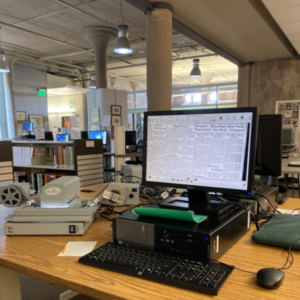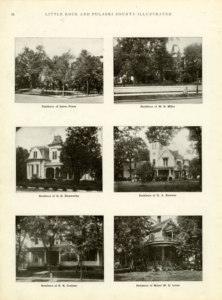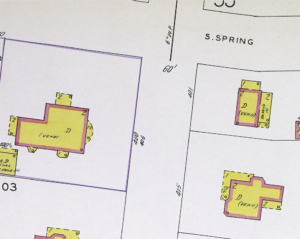calsfoundation@cals.org
For the Love of Old Houses: Preparing for the Quapaw Quarter Association’s Tour of Homes
Guest post by researcher Callie Williams

Throughout the last decade, I have explored the archives at the Central Arkansas Library System’s Butler Center for Arkansas Studies at the CALS Roberts Library to find the unique histories of the homes built in the historic neighborhoods of Little Rock. Every year in the early spring, I start researching the newest batch of historic homes that will be presented during the annual Quapaw Quarter Association’s Tour of Homes.
The Quapaw Quarter Association (QQA) presents its tour of homes each year, generally on the afternoons of Mother’s Day weekend. The tours feature homes that illustrate the interesting history of the area. These homes range from large Victorian-era mansions to small Craftsman-style bungalows to modern infill; all are selected and presented to tell stories that represent the various people who lived and worked in these beautiful and historic neighborhoods. The QQA grew out of the efforts by many local leaders and historians who worked to identify and protect the significant historic structures in Little Rock that were quickly disappearing during the urban renewal projects of the 1960s. The QQA continues to serve its mission to preserve Greater Little Rock’s historic places. Read more about the QQA in the CALS Encyclopedia of Arkansas here.

To prepare for the tour, I start gathering information on each of the homes so that the volunteer docents will have accurate historical information to relay to the tour guests. The tour is not only a fun social event, but also a chance to educate the public on the history of the neighborhoods of Little Rock. Each house is a new opportunity to showcase the history of those who lived and worked in the home, as well as its architectural style.
The Butler Center’s unique collections, available to patrons in the CALS Roberts Library Research Room, contain a wealth of knowledge on the architectural history of Little Rock (and much of Central Arkansas). I usually start with the files of the QQA, which include research and archival material gathered over decades related to the historic residential core of the city. Their collection includes hundreds of files, mostly organized by address. Other important collections that I like to peruse include turn-of-the-twentieth-century illustrated guides to the city, which provide a record of the historic appearance of many important houses as well as information on the general growth of the city. As Little Rock grew in the first decades of the twentieth century, advertisements for Little Rock as the “City of Roses” showcased prominent businesses as well as the stately homes of the town’s elite.
Other records can flesh out the histories of those who helped to build the houses and provide services inside the homes. The large collection of city directories held in the Roberts Library Research Room can often fill in gaps, as they list residents by address across the city for consecutive years. Equivalent to later telephone directories, these listings can confirm who lived in a house over a large span of time. Also, these directories sometimes show renters as well as service workers who lived on site. City directories can also give an idea of the makeup of a neighborhood, showing who owned their own home versus who rented. Once you curate a list of names associated with an address, you can easily research the associated family names across all the archival holdings of the library. These family searches, as well as the newspaper collections of the local Arkansas Democrat and Arkansas Gazette—both in partial digital and full microfilm collections—can expand the history for each house.

The other helpful resource available through CALS for historic home research is access to the Sanborn Fire Insurance Maps collections through their online databases. These maps were created by the Sanborn Map Company to provide important information on building location and construction materials to fire insurance companies so that they could assess liability and risk in urban areas across the United States. These maps were updated over several decades from the late 1800s through the mid-1900s. Today these maps serve as important documentation for urban areas, showing the development of neighborhoods and the historic footprints of buildings over large areas. These maps can also be important resources for dating additions or major alterations and marking the location of ancillary buildings such as carriage houses, separate kitchens, or early automobile garages.
The collections held in the CALS Roberts Library reveal the history of the built environment of historic Little Rock, illuminating the interesting stories that might have been lost long ago without the archival efforts to preserve and share them.
To learn more about the Quapaw Quarter Association’s Spring Tour of Homes, visit their website.
CALS Roberts Library Research Room Resources Used
Archival materials:
Digitized content:
- Little Rock “City of Roses” souvenir booklet, 1902-1903, QQA Records (BC.MSS.16.17)
- The Latest Views of Little Rock, Witsell-Carvill-Bruce family collection (BC.MSS.19.38)
- Little Rock and Pulaski County Arkansas Illustrated, 1907-1908, Quapaw Quarter Association records (BC.MSS.06.15)
CALS database resources:
- Fire Insurance Maps Online (accessible from home with a CALS card)
- Little Rock City Directories (several years available printed in the Roberts Library Research Room; also available via Ancestry.com in the Roberts Library or your closest CALS branch)




